Articles
- Page Path
- HOME > Restor Dent Endod > Volume 29(3); 2004 > Article
- Original Article Effect of surface defects and cross-sectional configuration on the fatigue fracture of NiTi rotary files under cyclic loading
- Yu-Mi Shin1, Eui-Sung Kim1, Kwang-Man Kim2, Kee-Yeon Kum1
-
2004;29(3):-272.
DOI: https://doi.org/10.5395/JKACD.2004.29.3.267
Published online: May 31, 2004
1Department of Conservative Dentistry, Yonsei University, Korea.
2Department of Dental Materials, Yonsei University, Korea.
- Corresponding author: Kee-Yeon Kum. Department of Endodontics, Youngdong Severance Hospital, College of Dentistry, Yonsei University, Dokok-Dong, Kangnam-Gu, 146-92, Seoul, 135-270, Korea. Tel: 82-2-3497-3566, Fax: 82-2-3463-0551, kum6139@yumc.yonsei.ac.kr
Copyright © 2004 Korean Academy of Conservative Dentistry
- 962 Views
- 2 Download
- 6 Crossref
Abstract
-
The purpose of this in vitro study was to evaluate the effect of surface defects and cross-sectional configuration of NiTi rotary files on the fatigue life under cyclic loading. Three NiTi rotary files (K3™, ProFile®, and HERO 642®) with #30/.04 taper were evaluated. Each rotary file was divided into 2 subgroups: control (no surface defects) and experimental group (artificial surface defects). A total of six groups of each 10 were tested. The NiTi rotary files were rotated at 300rpm using the apparatus which simulated curved canal (40 degree of curvature) until they fracture. The number of cycles to fracture was calculated and the fractured surfaces were observed with a scanning electron microscope. The data were analyzed statistically. The results showed that experimental groups with surface defects had lower number of cycles to fracture than control group but there was only a statistical significance between control and experimental group in the K3™ (p<0.05). There was no strong correlation between the cross-sectional configuration area and fracture resistance under experimental conditions. Several of fractured files demonstrated characteristic patterns of brittle fracture consistent with the propagation of pre-existing cracks.This data indicate that surface defects of NiTi rotary files may significantly decrease fatigue life and it may be one possible factor for early fracture of NiTi rotary files in clinical practice.
- 1. Mize SB, Pruett JP, Clement DJ, Carnes DL. Effect to sterilization on cyclic fatigue of rotary nickel-titanium endodontic instruments. J Endod. 1998;24(12):843-847.PubMed
- 2. Pruett JP, Clement DJ, Carnes DL. Cyclic fatigue testing of nickel-titanium endodontic instruments. J Endod. 1997;23(2):77-85.ArticlePubMed
- 3. Haikel Y, Serfaty R, Bateman G, Senger B, Allemann C. Dynamic and cyclic fatigue of engine-driven rotary nickel-titanium endodontic instruments. J Endod. 1999;25(6):434-440.ArticlePubMed
- 4. Kuhn G, Tavernier B, Jordan L. Influence of structure on Nickel-Titanium endodontic instrument failure. J Endod. 2001;27(8):516-520.PubMed
- 5. Karn T. Fractographic analysis of experimentally separated NiTi rotary files. 2003;University of Connecticut; MS Thesis.
- 6. Li UM, Lee BS, Shih CT, Lan WH, Lin CP. Cyclic fatigue of endodontic nickel-titanium rotary instruments: static and dynamic tests. J Endod. 2002;28(6):448-451.ArticlePubMed
- 7. Turpin YL, Chagneau F, Vulcain JM. Impact of two theoretical cross-sections on torsional and bending stresses of nickel-titanium root canal instrument models. J Endod. 2000;26(7):414-417.ArticlePubMed
- 8. Jeon IS, Spangberg LS, Yoon TC, Kazemi RB, Kum KY. Smear layer production of three NiTi rotary reamers in straight root canals. A SEM study. Oral Surg Oral Med Oral Pathol Oral Radiol Endod. 2003;96(5):601-607.PubMed
REFERENCES
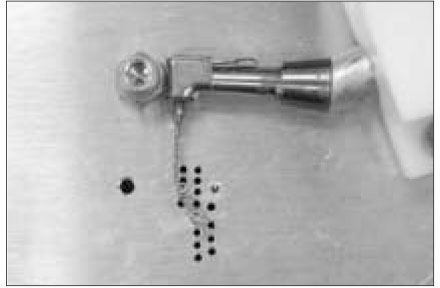
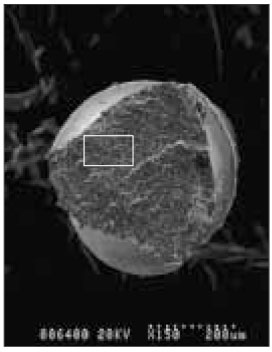
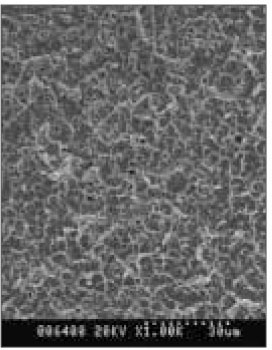
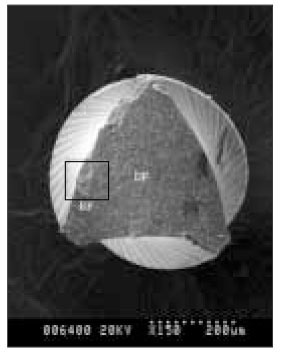
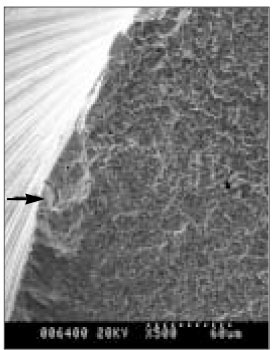
Tables & Figures
REFERENCES
Citations

- Torsional behavior and microstructure characterization of additively manufactured NiTi shape memory alloy tubes
Keyvan Safaei, Mohammadreza Nematollahi, Parisa Bayati, Hediyeh Dabbaghi, Othmane Benafan, Mohammad Elahinia
Engineering Structures.2021; 226: 111383. CrossRef - Effect of internal stress on cyclic fatigue failure in K3
Jun-Young Kim, Jin-Woo Kim, Kyung-Mo Cho, Se-Hee Park
Restorative Dentistry & Endodontics.2012; 37(2): 74. CrossRef - An evaluation of rotational stability in endodontic electronic motors
Se-Hee Park, Hyun-Woo Seo, Chan-Ui Hong
Journal of Korean Academy of Conservative Dentistry.2010; 35(4): 246. CrossRef - Effect of cross-sectional area of 6 nickel-titanium rotary instruments on the fatigue fracture under cyclic flexural stress: A fractographic analysis
Soo-Youn Hwang, So-Ram Oh, Yoon Lee, Sang-Min Lim, Kee-Yeon Kum
Journal of Korean Academy of Conservative Dentistry.2009; 34(5): 424. CrossRef - The Effect of Surface Defects on the Cyclic Fatigue Fracture of HEROShaper Ni-Ti rotary files in a Dynamic Model: A Fractographic Analysis
Jung-Kyu Lee, Eui-Sung Kim, Myoung-Whai Kang, Kee-Yeon Kum
Journal of Korean Academy of Conservative Dentistry.2007; 32(2): 130. CrossRef - Comparative study on morphology of cross-section and cyclic fatigue test with different rotary NiTi files and handling methods
Jae-Gwan Kim, Kee-Yeon Kum, Eui-Seong Kim
Journal of Korean Academy of Conservative Dentistry.2006; 31(2): 96. CrossRef
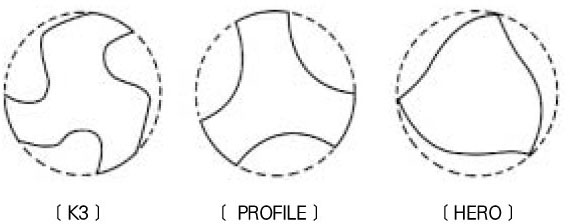

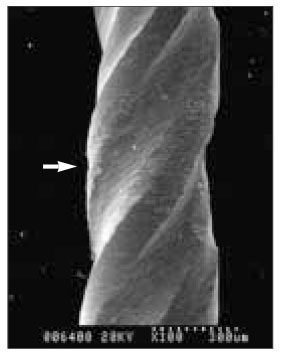




Figure 1
Figure 2
Figure 3
Figure 4
Figure 5
Figure 6
Figure 7
Study Design of control and experimental groups.
Mean number of cycles to fracture and statistical comparison between control and experimental group of each file system.
S: Statistically significant at p < 0.05 (Wilcoxon Rank Sum Test). NS: Non-significant
Number of cycles to fracture = Time to fracture (sec)×5 (300 rpm = 300 cycles/min)
Statistical comparison between the number of cycles to fracture and the cross sectional configuration area at 5 mm level.
†Statistically significant between cross sectional area (D5) and number of cycles to fracture (Kruskal-Wallis test, p < 0.05)
S: Statistically significant at p < 0.05 (Wilcoxon Rank Sum Test). NS: Non-significant Number of cycles to fracture = Time to fracture (sec)×5 (300 rpm = 300 cycles/min)
†Statistically significant between cross sectional area (D5) and number of cycles to fracture (Kruskal-Wallis test, p < 0.05)

 KACD
KACD





 ePub Link
ePub Link Cite
Cite

